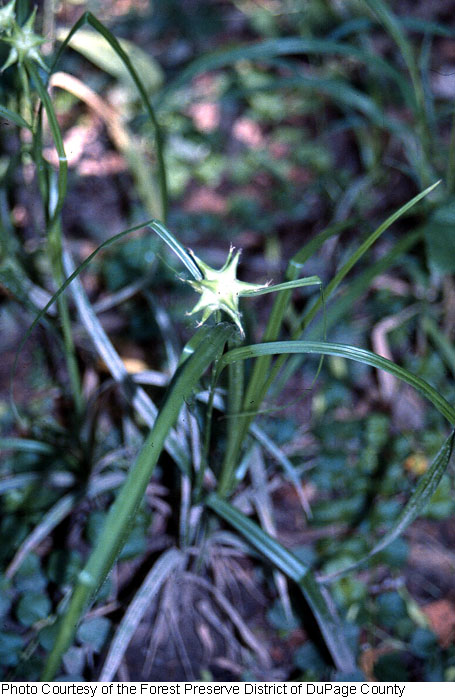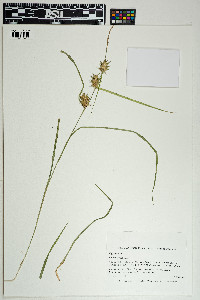|
|
|
|
Family: Cyperaceae
Gray's sedge, more...hybrid bladder sedge
[Carex asa-grayi L.H.Bailey, moreCarex grayi var. hispidula A.Gray ex L.H.Bailey] |
Plants cespitose or not, short-rhizomatous. Culms solitary or not, erect, (25-)40-90(-110) cm. Leaves 6-12; basal sheaths purplish red; sheath of distal leaf 0-1.5(-2.5) cm; ligules rounded, 2.5-6 mm; blades 12-34 cm × 4-11 mm. Inflorescences 2.5-17 cm; peduncles of proximal pistillate spikes 0.7-3.5 cm, basal 2 peduncles 1-4(-12) cm apart; peduncle of terminal spike 0.5-6 cm; bracts leafy, usually sheathless, blades 8-26 cm × 2-7 mm. Spikes: proximal pistillate spikes 1-2(-3), densely (4-)8-35-flowered, separate to aggregated, globular, 2.5-4.2 × 2.6-4.1 cm; terminal staminate spike 1, 0.5-6.5 cm × 1-4 mm. Pistillate scales 1-5-veined, lanceolate-ovate to ovate-orbicular, 4-11 × 2-4.2 mm, apex obtuse to awned, awn to 7 mm, rough. Anthers 3, 2.5-4.8 mm. Perigynia radiating out in all directions, strongly 16-25-veined, rhombic-ovoid, 12.5-20 × 4-8 mm, base cuneate, dull, glabrous or, sometimes, hispidulous; beak poorly defined, 1.5-3 mm. Achenes sessile, ellipsoid to obovoid, faces convex, angles not thickened, 3.3-4.8 × 2.6-3.7 mm; style withering. Fruiting May-Aug. Mesic to wet deciduous forests, forest openings, usually on fine alluvial or lacustrine deposits, riverbottoms; 0-500 m; Ont., Que.; Ala., Ark., Conn., Del., D.C., Fla., Ga., Ill., Ind., Iowa, Kans., Ky., Md., Mass., Mich., Minn., Miss., Mo., N.Y., N.C., Ohio, Okla., Pa., S.C., Tenn., Vt., Va., Wis. Pubescence on the perigynia of Carex grayi is most frequently found in plants from the Midwest and South.
Stems 3-9 dm, solitary or in small clusters, scabrous on the angles above; rhizomes wanting; basal sheaths persistent, purplish-red; lvs 4-11 mm wide, the uppermost nonbracteal one (as also the bracts) sheathless or with a sheath seldom over 1 cm; terminal spike staminate, 0.5-5.5 cm, on a peduncle of 0.5-6 cm; pistillate spikes 1 or 2, densely fld, globular, ±approximate, on peduncles 0.7- 3.5 cm, their bracts leafy, 8-26 cm; pistillate scales 4-11 mm, lance-ovate to orbicular-ovate, often tipped with a rough awn to 7 mm; perigynia 8-35, radiating in all directions from the short axis, dull, sometimes hispidulous, 12.5-20 נ4-8 mm, strongly 16-25-nerved, rhombic-ovoid, cuneate to the base, tapering from the widest point to a poorly defined, bidentate beak 1.5-3 mm, the teeth hispidulous internally; achene 3.3-4.8 נ2.6-3.7 mm, convexly trigonous, not thickened on the angles; style persistent but withering, sometimes contorted; 2n=52, 54. Moist woods; Mass., Vt., s. Que., and s. Ont. to Wis. and se. Minn., s. to Ga. and Mo. Gleason, Henry A. & Cronquist, Arthur J. 1991. Manual of vascular plants of northeastern United States and adjacent Canada. lxxv + 910 pp. ©The New York Botanical Garden. All rights reserved. Used by permission. |




